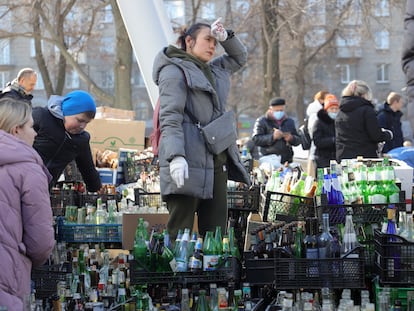Is Putin willing to press the nuclear button? Keys to understanding the Kremlin’s strategy
The Russian president has put the army’s deterrence forces on ‘special mode of combat duty,’ but experts are divided on whether he is really prepared to act on his threats against Ukraine

On February 27, Russian President Vladimir Putin ordered his defense chiefs to place the country’s nuclear forces on a “special mode of combat duty.” In the early hours of February 24, when he made his televised statement announcing the invasion of Ukraine, he made another barely veiled threat, warning other countries not to interfere or otherwise they could face “consequences they have never seen.” Days before the attack began, Russian armed forces had carried out maneuvers using weapons with a nuclear capability.
What does the order given to the defense minister and the chief of the general staff of the armed forces of the Russian Federation mean technically? What is the underlying logic of Putin ramping up the nuclear rhetoric? Is the Russian leader genuinely prepared to be the first to detonate a nuclear device against an enemy since the attacks on Hiroshima and Nagasaki during the Second World War? The use of the nuclear threat by the leader of a superpower, the most worrying in decades, is greatly worsening the tensions that have been unleashed by Russia’s assault on Ukraine.
So far, the reaction of Western leaders has been contained. The United States has not raised its nuclear alert levels, and the official messages have condemned Putin’s escalation but are seeking to convey calm. A significant proportion of experts believe that the nuclear option is so delusional as to be implausible. “We all know that Putin is unpredictable, that he does things that no one would believe he would do, but I think that this is not possible,” says William Alberque, the director of strategy, technology and arms control at the International Institute for Strategic Studies (IISS) in London.
But there are others who disagree. Francesca Giovannini, the executive director of the Project on Managing the Atom at the Harvard Kennedy School’s Belfer Center for Science, believes that the nuclear option, while improbable, should not be completely ruled out. “The circumstances are very complex,” she argues. “And he [Putin] is under a huge amount of pressure.”
It’s impossible to know exactly what is going on in the head of the person that would have to give the order to launch such an attack, but there are a number of elements that provide context to interpret the situation. Here are some of those.
The technical meaning of Putin’s order
The instruction given by Putin on Sunday does not clearly fit within the Russian nuclear categories that are known about in the West. Government civil servants and experts have pointed to the fact that they do not correspond to a standardized nomenclature like the DEFCON system in the United States, and also that this is not a maximum state of alert and is more likely a new kind of political message.
On Monday night, Pentagon sources cited by the Reuters news agency said that they had not detected any relevant movements of weapons. The Russian defense minister, Sergei Shoigu, reported to President Putin on Monday that the measure he had requested had been implemented, and that personnel in positions within the nuclear command structure had been strengthened, according to the TASS Russian news agency. If this was the only consequence of the move, it would be a substantially irrelevant measure.
Both Russia and the United States – the world’s main nuclear powers – always have a percentage of their nuclear arsenals ready to use. These consist of a strategic part, which is long range, and includes missiles launched from the ground (either from silos or mobile units), from the sea (in submarines), or by air (in bombers); and then there is a tactical section, with a lower range, and also with less-powerful warheads.
These weapons act as a deterrent according to the credibility of the response, and that is why part of the arsenal is always ready to be used at a moment’s notice. Last December, Russia’s Chief of the General Staff Valery Gerasimov, stated that 95% of the country’s strategic nuclear missiles are constantly in a state of combat readiness. The alert level can rise by increasing the number of warheads loaded onto missiles, increasing the number of armed submarines that are deployed, etc. But, at least for now, steps of this kind do not appear to have been taken by Russia.
The logic of Putin’s rhetorical escalation is quite clear. “What his message shows is that he wants to win this war with Ukraine, he fears that the West will intervene directly and he wants to ensure that we are all outside of the conflict,” explains Alberque, who worked for NATO before joining IISS.
The Western countries have made it clear that they have no intention of fighting against Russia, but Putin has been seeing a growing willingness to send arms to Ukraine. His threats are seeking to introduce the most extreme and worrying variable in the calculations of the West right from the start, with the hope that it will serve as an element that will inhibit future decisions.
The Russian nuclear doctrine
The Russian doctrine that came into force via an executive order from Putin on July 2, 2020 establishes four conditions under which Russia would use its nuclear arms:
- The receipt of reliable data on the launch of ballistic missiles against the territory of the Russian Federation and/or its allies;
- The use of nuclear arms or other weapons of mass destruction by an adversary against the Russian Federation and/or its allies;
- An attack by an adversary against critical Russian Federation military or governmental infrastructure, the disruption of which would undermine its nuclear response capacity;
- An attack against the Russian Federation with the use of conventional arms when this puts the existence of the state in danger.
None of these conditions appear to be remotely conceivable at the current time. To justify his decision, Putin has cited “aggressive statements” made by some of the NATO high command.
The willingness to do the unthinkable
Normal logic would lead one to think that it is inconceivable that Putin would order a nuclear attack in circumstances like these. It is implausible that the conditions in the Russian doctrine be met, and the retaliation that could be triggered would be unprecedented. This is one of the arguments cited by Alberque to rule out this option.
“I believe that it would trigger a generalized reaction that would lead to the total isolation of Russia,” the expert explains. “Even countries such as China would take steps in this direction. Things like the expulsion of Russia from the UN Security Council would be considered and this would really be the beginning of the end of Russia. I believe that Putin knows that this is a credible scenario.”
Alberque also points to military arguments. “Where would he launch the bomb? In the Black Sea or in a forest, like a warning with radioactive consequences? Or a monstrosity in a city? The Ukrainian forces are not massed together for a precise strike against them to make sense… There is no option that makes sense.”
What’s more, as many experts have pointed out, the Russian armed forces have huge firepower just with their conventional weapons, meaning they could cause mass destruction without having to resort to nuclear arms.
But there are others who don’t see the situation so clearly. Firstly due to the proven track record of Vladimir Putin when it comes to breaking boundaries, making unpredictable moves, of being prepared to take on growing risks to defend his interests. Then some began to point to a possible loss of a certain sense of reality, which is impossible to prove or otherwise, but which is now hanging over him. The autocrat has lived a prolonged solitude, accustomed to the widespread sense of paranoia from the USSR, and of course, from the KGB, which were his training grounds. After meeting him in 2014, former German chancellor Angela Merkel told then-US president Barack Obama that she felt like Putin lived in another world, according to The New York Times.
And then there are the extreme circumstances of the moment. “I think that he is under huge internal pressure,” says Giovannini. “He’s not crazy. I don’t think that he would launch a strategic bomb. But it worries me that he could consider the option of a tactical one. To send a message that he is prepared to do anything to defend Russian interests. Thinking that perhaps an attack with a tactical warhead in Ukraine would not trigger a military reaction from NATO against Russia.”
Other respected experts, such as François Heisbourg, have also suggested that the threat cannot be completely ruled out, among other things, because history has shown that Putin does not bluff.
The United States and Russia have the largest nuclear arsenals in the world – in fact, the latter is slightly superior in quantitative terms, according to data from the Bulletin of the Atomic Scientists, with 6,000 nuclear warheads in total. The deployment of strategic arms is limited by the New START treaty, which was signed by the US and Russia. The nuclear dimension has been of key importance during Putin’s drive to modernize the Russian armed forces. Defense Minister Shoigu reported in December that, as a result of years of work, modern arms and equipment now account for 89% of the “nuclear trio” of earth, sea and air. Russia has developed new delivery systems, and also has a wide-ranging arsenal of tactical nuclear warheads.
The ramping up of the nuclear rhetoric comes in a worrying context. On the one hand, it should be noted that Belarus has just held a referendum to modify its Constitution and allow for its conversion into a nuclear state. It was approved with 65% of votes in favor, according to data from the regime.
On the other hand, this is an important time right now for the renegotiation of the nuclear pact with Iran, a process that has been underway for many months and that is far from simple.
Meanwhile, the administration of US President Joe Biden is working to define its nuclear doctrine, and Putin’s threats could influence this process and give arguments to those who are pushing for more aggressive red lines to be set. Without a doubt, this will consolidate the perspective of the prolonged presence of US nuclear arms on European bases, something that in the past has been the object of intense debates. This is another adverse effect caused by the Kremlin’s own initiatives – the latest in what is becoming a very long list.
Tu suscripción se está usando en otro dispositivo
¿Quieres añadir otro usuario a tu suscripción?
Si continúas leyendo en este dispositivo, no se podrá leer en el otro.
FlechaTu suscripción se está usando en otro dispositivo y solo puedes acceder a EL PAÍS desde un dispositivo a la vez.
Si quieres compartir tu cuenta, cambia tu suscripción a la modalidad Premium, así podrás añadir otro usuario. Cada uno accederá con su propia cuenta de email, lo que os permitirá personalizar vuestra experiencia en EL PAÍS.
¿Tienes una suscripción de empresa? Accede aquí para contratar más cuentas.
En el caso de no saber quién está usando tu cuenta, te recomendamos cambiar tu contraseña aquí.
Si decides continuar compartiendo tu cuenta, este mensaje se mostrará en tu dispositivo y en el de la otra persona que está usando tu cuenta de forma indefinida, afectando a tu experiencia de lectura. Puedes consultar aquí los términos y condiciones de la suscripción digital.
More information
Últimas noticias
More than 40 Democratic lawmakers urge Trump in a letter to stop his ‘attempts to undermine democracy in Brazil’
The journal ‘Science’ criticizes Trump’s anti-renewable energy policy: ‘The US is failing to benefit from its own innovations’
Cubans hope for a miracle as dengue and chikungunya spread
The long shadow of the father figure in the films of Rob Reiner
Most viewed
- Christian Louboutin: ‘Young people don’t want to be like their parents. And if their parents wear sneakers, they’re going to look for something else’
- Cartels in Mexico take a leap forward with narco-drones: ‘It is criminal groups that are leading the innovation race’
- ‘El Limones’ and the growing union disguise of Mexican organized crime
- Liset Menéndez de la Prida, neuroscientist: ‘It’s not normal to constantly seek pleasure; it’s important to be bored, to be calm’
- The low-cost creative revolution: How technology is making art accessible to everyone











































